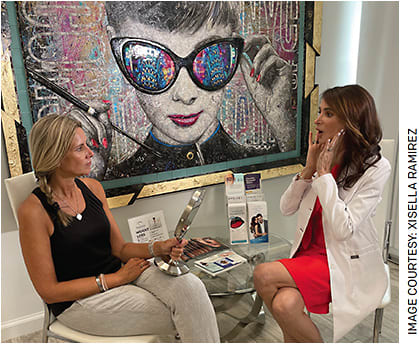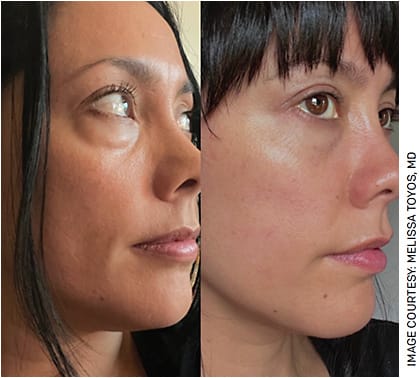Aesthetics and oculoplastics are “having a moment.” Why should ophthalmologists consider incorporating them into their practices? It’s simple: Our patients care about their appearance now more than ever before and are ready to put in the time and dollars to correct and prevent skin issues. As physicians with the skill, knowledge and dexterity to deal with the focal point of the face and who have earned the trust of our patients by taking care of their sight, ophthalmologists are in a unique situation to address these cosmetic concerns.
Another driver for ophthalmologists to consider an aesthetics practice is the cash-pay aspect: Having had a taste of other “aesthetic” procedures like LASIK, SMILE and refractive lens exchange, many are finding that offering aesthetic services is a great way to hedge their bets against never-ending reimbursement cuts and overhead increases. I began offering aesthetic procedures in my first year of practice. Having been bitten by the Botox (onabotulinumtoxinA, Allergan) bug, I immediately saw the value and interest my patients had in both seeing and looking better (Figure 1).

FIGURE 1. Dr. Toyos and patient discuss the patient’s expectations for her procedure.
But whether you already have a medspa in your office or you want to get started, aesthetics can be a rewarding part of your practice, both personally and professionally.
WHERE TO START
Offering aesthetics procedures doesn’t have to be expensive or time-consuming. I initially built my aesthetics practice by simply discussing blepharoplasty with appropriate patients. My cataract patients were a natural source. Once they could see better, they noticed things — including their own droopy eyelids. I also began mentioning lid surgery to anyone whose eyelids I had to prop lids open in order to see into their fundus or at the laser. It may surprise you to learn that most patients care more about getting their lids fixed than their cataracts — even when they aren’t legal to drive from cataracts!
Injectables are another easy entry point. Many of us are already trained to use Botox for blepharospasm and expanding its use (ie, the TikTok favorite, “lip flip”) is a natural segue into the aesthetics market. Of course, Botox is a gateway to the use of fillers and the strategic use of Kybella (deoxycholic acid) injection 10 mo/ml, Allergan), which can naturally follow with no increase in overhead to make them a natural segue.
Another easy entry point for the general ophthalmologist: non-invasive blepharoplasty with a CO2 laser (Figure 2). Resurfacing with the MIXTO laser (Lasering USA) continues to be a practice builder in at Toyos Clinics. Perfect for those patients whose lids aren’t quite touching their lashes or who would like to avoid surgery, these procedures offer patients scar-free, immediate improvement and long-lasting results (upwards of 5 years).

FIGURE 2. Lower lid blepharoplasty with MIXTO laser
ADDITIONAL EYE-CENTRIC PROCEDURES
Eyedrops as aesthetic or lifestyle medications are also hitting their stride. Latisse (bimatoprost ophthalmic solution 0.03%, Allergan) will always be the “OG” eyedrop for lash growth aesthetics, but we now have Lumify (Bausch + Lomb) eyedrops for eye whitening and the temporary improvement of conjunctival chalasis, and Upneeq (oxymetazoline hydrochloride ophthalmic solution), 0.1%, Osmotica) for lid lifting.
Upneeq is following a direct-to-consumer pathway, but in my practice it is useful for younger patients craving facial symmetry in their selfies, older patients who aren’t ready for or don’t have time for lid surgery, and even for people who just want a test run while considering lid surgery. I use Upneeq preoperatively so patients can enjoy improved lids while waiting for surgery and post-surgically to help patients with swelling that can temporarily make their eyes look smaller while they heal.1
Intense pulsed light (IPL) therapy is a great way to wade gently into the aesthetics waters by treating ocular rosacea and dry eye. Many patients being treated for dry eye will request a few additional flashes of light to treat their facial rosacea or the odd acute chalazion. I also use it to boost collagen and treat pigmentation, sun spots, acne, Demodex and dark under-eye circles.
Another splashy trend this year was eyebrow transplantation. Latisse and similar products have a long track record of lash and brow growth enhancement, but this year follicular unit extraction eyebrow transplants became hot when celebrities like Chrissy Teigen and Meagan Good showed off their “brow-tastic” results on Instagram. Patients called our offices to learn more about how to grow natural looking brows.
In-office aesthetics procedures are another trend that continues to gain traction. Ophthalmologists considering procedures such as upper and lower blepharoplasty, entropion, ectropion and ptosis should feel even more comfortable now that cataract surgery and even retina surgeries have been making their way into the office.
THE SOCIAL MEDIA EFFECT: TIKTOK AND ZOOM
There is no denying that social media is having a significant impact on both the aesthetics and oculoplastics markets. Patients for these procedures skew younger and have grown up with an acceptance of aesthetics treatments and what the American Academy of Facial Plastic and Reconstructive Surgery calls “selfie-awareness,” aka “TikTok face.” The group reports an increase from 16% to 79% in the last year alone in facial procedures requested to enhance a patient’s appearance on video.2
The TikTok fluid filters have made aspirational skin a reality with filters that move seamlessly across video to slim noses, smooth wrinkles and pores and to add eyelashes and even hair volume. Little wonder that after experiencing a better version of themselves on TikTok, patients want to make an appointment with you to achieve the same results sans filters.
Speaking of TikTok, “Fox eye” is another trend the platform has popularized that is likely to make its way into your oculoplastics practice. Kendall Jenner is the poster girl for the cosmetically attractive almond-shaped eye that can be achieved with the same lateral tarsal strip that we use to treat senile entropion and ectropion.
Most aesthetics patients are still women, but the growth in male interest has been steady and solid. The American Society of Plastic Surgeons reports that male cosmetic procedures rose 29% between 2000 and 20183 — and that was before COVID shutdowns when Zoom meetings became the norm for many workplaces.
The trends in male interest seem to depend more on the geographic region and their chosen careers. For example, the men in Silicon Valley search for rejuvenating treatments to combat ageism (over 40 is prehistoric in the tech industry) and on the other coast, power players in our capitol are looking for treatments that help to present a more masculine appearance (Superman-style jawlines created with filler) and Botox to conceal facial expressions.4
BEYOND THE EYE
Ophthalmologists ready for a deeper dive into the world of aesthetics may want to consider services and procedures beyond the eye. Read on for some recent hot trends.
Body sculpting has also become a hot topic — hardly a surprise given that Americans gained on average 2 pounds per week during the most intense months of COVID shutdown in 2020, according to the Journal of the American Medical Association. With more than 61% of US adults reporting unwanted weight changes,5 it is no wonder that patients are seeking solutions dealing with unwanted fat using cold-freezing, radio-frequency heating and even injectable (Kybella) solutions.
In June, janus kinase (JAK) inhibitor Olumiant (baricitinib, Eli Lilly) became the first FDA approved medication for the treatment of severe alopecia areata. Clinical trials showed the results were dramatic, with significant number of patients taking Olumiant achieving 80% scalp hair coverage and about a quarter of subjects seeing 90% or greater scalp hair coverage.6
Opzelura (ruxolitinib, Incyte Corp.), another JAK inhibitor, is the first and only approved topical cream form of the drug. It was approved by the FDA in 2021 for the treatment of atopic dermatitis, and in July it was approved as the first ever topical treatment for the chronic skin disorder nonsegmental vitiligo. Re-pigmentation and results take up to a year, and, like other JAK inhibitors, carry black box warnings.
OPTIONS ABOUND
Most general ophthalmologists receive plastics training during their residencies, but the amount and quality can vary. Once in practice, there are several opportunities for those interested in learning more about aesthetics to get started. Many manufacturers offer free training for injections, IPL and laser procedures. You could shadow a physician who performs aesthetics procedures. Also, certification courses are offered at national conferences by many academic centers and at smaller hands-on conferences such as Toyos Clinics’ own Technology, Aesthetics and Dry Eye conferences.
In the end, choose procedures that you feel comfortable with and that satisfy a niche in your local market. With dry eye prevalence booming and no slowdown in sight for social media use, the sky is the limit for your own aesthetics practice! OM
REFERENCES
- McNeil R. Developments in oculoplastic surgery. Eye News. https://www.eyenews.uk.com/features/ophthalmology/post/developments-in-oculoplastic-surgery . Accessed July 23, 2022.
- AAFPRS announces annual survey results: Demand for facial plastic surgery skyrockets as pandemic drags on. Feb. 10, 2022. https://www.prnewswire.com/news-releases/aafprs-announces-annual-survey-results-demand-for-facial-plastic-surgery-skyrockets-as-pandemic-drags-on-301478132.html . Accessed Aug. 30, 2022.
- Smith K. Male plastic surgery is on the rise — Here’s why. Aug. 15, 2019. https://tinyurl.com/2s3nzjma . Accessed Sept. 1, 2022.
- Holley P. In Silicon Valley, some men say cosmetic procedures are essential to a career. Jan. 9, 2020. https://www.washingtonpost.com/technology/2020/01/09/silicon-valley-some-men-say-cosmetic-procedures-are-essential-career . Accessed Aug. 30, 2022.
- American Psychological Association. One year on: Unhealthy weight gains, increased drinking reported by Americans coping with pandemic stress. Mar. 11, 2021. https://www.apa.org/news/press/releases/2021/03/one-year-pandemic-stress . Accessed Aug. 30, 2022.
- FDA approves Lilly and Incyte’s Olumiant (baricitinib) as first and only systemic medication for adults with severe alopecia areata. Jun. 13, 2022. https://investor.lilly.com/news-releases/news-release-details/fda-approves-lilly-and-incytes-olumiantr-baricitinib-first-and . Accessed Sept. 6, 2022.









